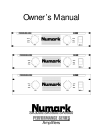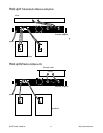
©1997 Numark Industries http://www.numark.com
11
The variable resistor is to ensure an impedance balance
between the positive and negative inputs, and should be
adjusted until any hum is at a minimum.
Balanced lines are also the most effective means of
reducing or eliminating RF or ‘radio frequency
interference’. Long unbalanced cable runs are likely to
pick up radio signals. While these will be at a low level,
they can be easily audible once they are amplified
through a gain stage. This also applies to inputs to your
mixer, so use balanced inputs wherever possible.
Losses Due to Cable Runs
To connect the speakers to the amplifier, some type of
cable must be used. This cable must be able to carry the
signal some distance with the minimum amount of
degradation along the way. Unlike earlier stages in the
audio chain, the signal is at a relatively high level,
therefore it is relatively immune to noise, RF interference
and hum. However, power losses and a reduction in
damping factor (the ability of the amp to control the
speaker accurately) can occur, and these depend on a
number of factors:
• cable gauge - the higher the gauge, the smaller the
cross section of each conductor in the wire. This
gives the signal more resistance and therefore results
in more power loss and a reduction in damping
factor. For best performance use 8, 10 or 12 gauge
cables as opposed to 16 or 18 gauge.
• cable length - the longer the cable, the higher the
losses. For best performance use the shortest
possible cable (i.e. don’t use a 100ft cable to connect
to an amp that is only 20ft from the speakers).
• speaker load - a 4 ohm load will have double the
power loss associated with an 8 ohm load and half
the damping factor.
The difference that these factors can make is significant.
For example, a Numark amp with 5ft of 12 gauge cable
and an 8 ohm load will have a power loss of 0.2% and a
damping factor of 142. The same load with a 40ft, 10
gauge cable will have a power loss of 1% and a
damping factor of 67. Increasing the cable length to 320ft
of 8 gauge, the losses are 5% and the damping factor is
just 18.2.
Overload
It may seem an obvious point to make, but overloading
speakers can permanently damage them, so care should
be taken to select speakers capable of handling the rated
power output and peak output of the amp. If the system
uses a crossover, ensure that the high frequency
‘tweeter’ cabinets are not driven with signals of a lower
frequency than they are designed for, either by wrongly
setting the crossover, or by hum which appears in the
amp or anywhere between the crossover and the amp.
Another overload which should be avoided is that of the
human ear. Observe health and safety regulations where
necessary regarding levels and exposure times.
Bridged Mono Operation
The amp comes factory configured for stereo operation. In
this mode, each channel drives a separate speaker load
with a separate signal. However, in some
circumstances, it may be necessary or desirable to drive
a single load at a higher level. This can be achieved
using the amp in bridged mono mode.
What this essentially does is uses one signal in positive
polarity through one terminal and negative through the
other. The combined voltage across the terminals is then
twice what it would be between a positive terminal and
speaker ground (0 V). This is like two cars driving
towards each other at 50mph; the relative speed between
the two is actually 100mph.
Note that in this way, a load of twice the impedance can
be driven at twice the power compared to stereo
operation (see specifications).
In order to configure your Numark amplifier for bridged
mono operation, follow the instructions listed under
bridged mono, 10 in each amplifier’s description (front half
of manual).
CAUTION
The speaker outputs of the Performance Series can be
high enough to constitute a shock hazard (especially in
bridged mono mode). Always make speaker connections
with the power off, and ensure that there are no loose
strands to cause short circuits.


















